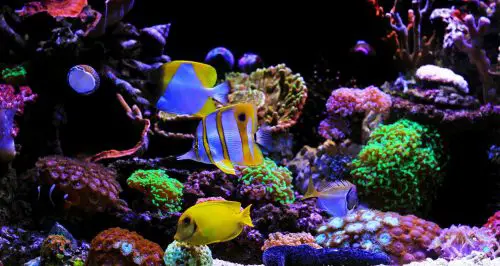How hard is it to maintain a Saltwater Fish Tank? This article will help you learn how to set up and maintain a saltwater fish tank.
When it comes to maintaining a saltwater fish tank, most people are clueless about the process involved in setting up one.
It is not hard to maintain a saltwater fish tank.
However, it will take around an hour for simple maintenance per day.
For example, it is necessary to change the water regularly and clean or replace siphoners so that water may flow through; filters must be examined and cleaned every week.
Remember that the filter removes bacteria from the water column – that means that once every three months,
you’ll need to replace the filter with new activated carbon (you can usually buy this at your pet store).
And finally, there’s monitoring – checking salinity levels for signs of excess algae growth,
checking your pH levels (you might want to find out what type of fish you own first),
taking measurements of oxygen levels in the water at different times of day, monitoring your fish for signs of stress.
And that’s just the basics – expect to do much more if you have a reef tank!
How Hard is it to Maintain a Saltwater Fish Tank? to know first What is a saltwater Fish Tank?
A saltwater tank usually consists of three basic components:
- A tank with live rock, live sand, and live coral that can’t get out.
- A protein skimmer removes organic compounds from the water column and dissolves particulate matter by creating bubbles that perform a “polishing” action on the surrounding water.
- Filter pads, plates, or a Berlin filter for larger installations are alternative means of filtration.
Saltwater fish tanks typically range in size from 10 to 480 gallons.
On average, a saltwater tank is about 20 gallons and holds at least one species of salt water-related animal.
It includes sea life like tangs, damsels, codes, triggerfish, lionfish, urchins, etc.
Some Popular Fish
While freshwater fish are usually more popular for keeping as pets, saltwater fish are catching up.
If you want to go for a livebearer tank, here is our list of 20 saltwater fish that you should know about.

Mandarinfish
Mandarinfish are a type of reef fish that live in the Pacific Ocean near Japan and Indonesia.
They have been around for over 37 million years but have only been seen by humans since 1938.
Mandarinfish are unique because they change their color according to the specific color of their environment.
It helps them camouflage better to hunt, mate, and hide from predators when necessary.
These fish do not go extinct because they reproduce very rapidly; a female can lay up to 1-3 million eggs at one time!
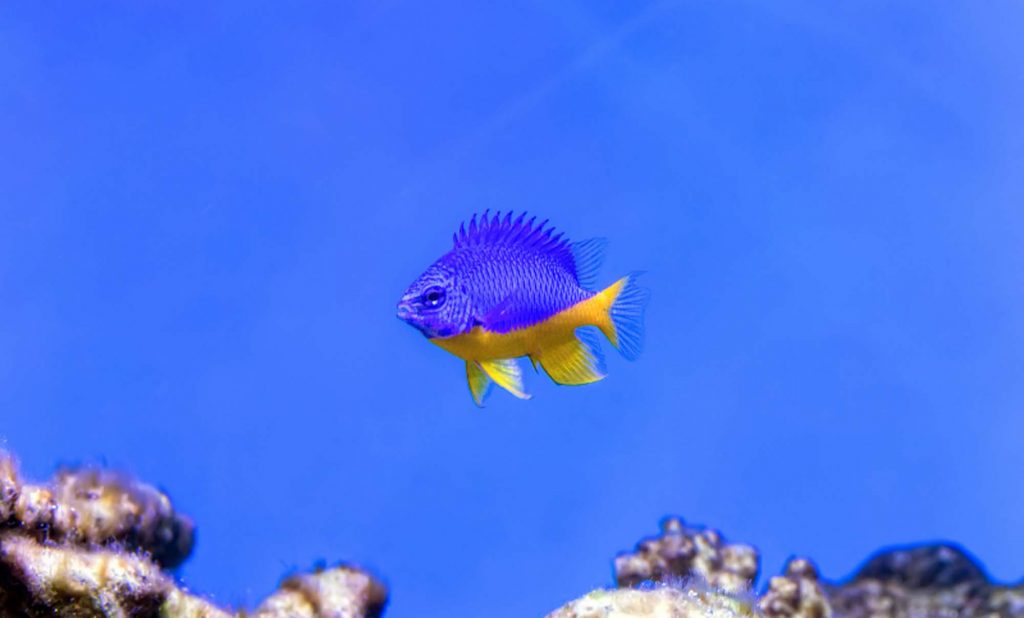
Azure Damselfish
The Azure Damselfish is a popular aquarium fish due to its vibrant coloring and hardy nature.
They are fairly easy to care for but have some special requirements for their habitat that they must meet to keep them healthy.
The Azure can grow up to 10 centimeters or 4 inches long and has 2-3 years of life expectancy.
They are usually blue with yellow stripes on their back, but they can also be gray-green with dark green spots.
This fish has an oval body shape that tapers toward the tail fin, lined by horizontal black bars.

Domino Damselfish
There are many types of damselfish out in the ocean, but one common type is domino damselfish.
These fish live on coral reefs and can be found anywhere from Indonesia to Hawaii.
They have an average lifetime of five years and seldom exceed a height of three inches.
Domino Damselfishes get their name from their black stripes that resemble dominos.
They also have two large white spots on the side of their body.
Which look like eyes for predators to think they’re looking at them when they’re just camouflaged against the corals below!
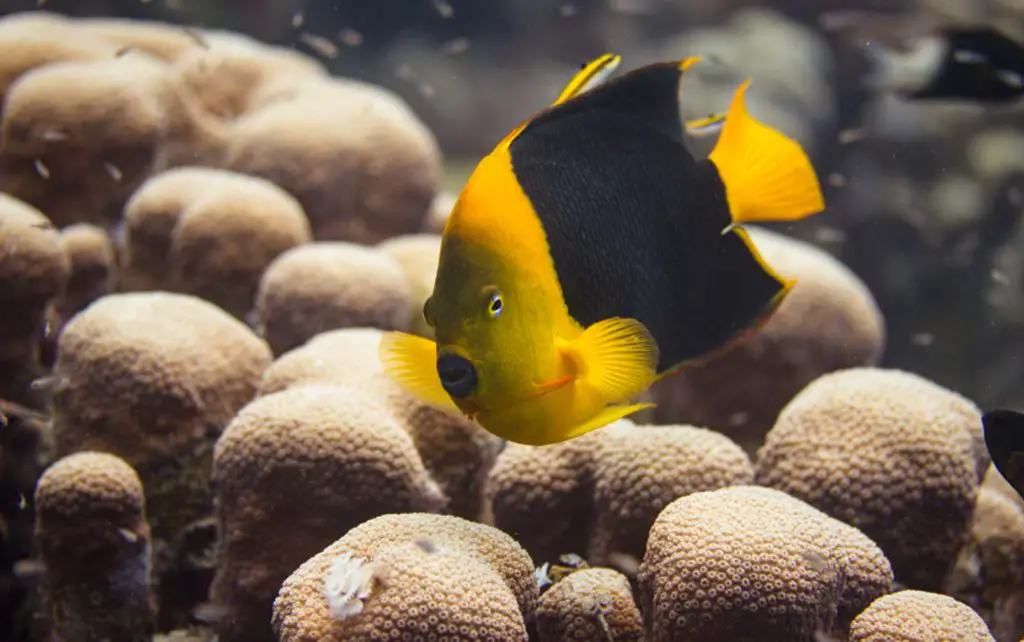
Coral Beauty Angelfish
Coral beauty fish is a type of angelfish that is found in the Caribbean.
These beautiful creatures are found all over coral reefs and live to be about 12-14 inches long.
Coral beauty fish get their name from their colorful, iridescent scales, ranging from white to orange with black spots on them.
They have a wide mouth and swim upright like other angelfish such as butterflies or triggerfish.
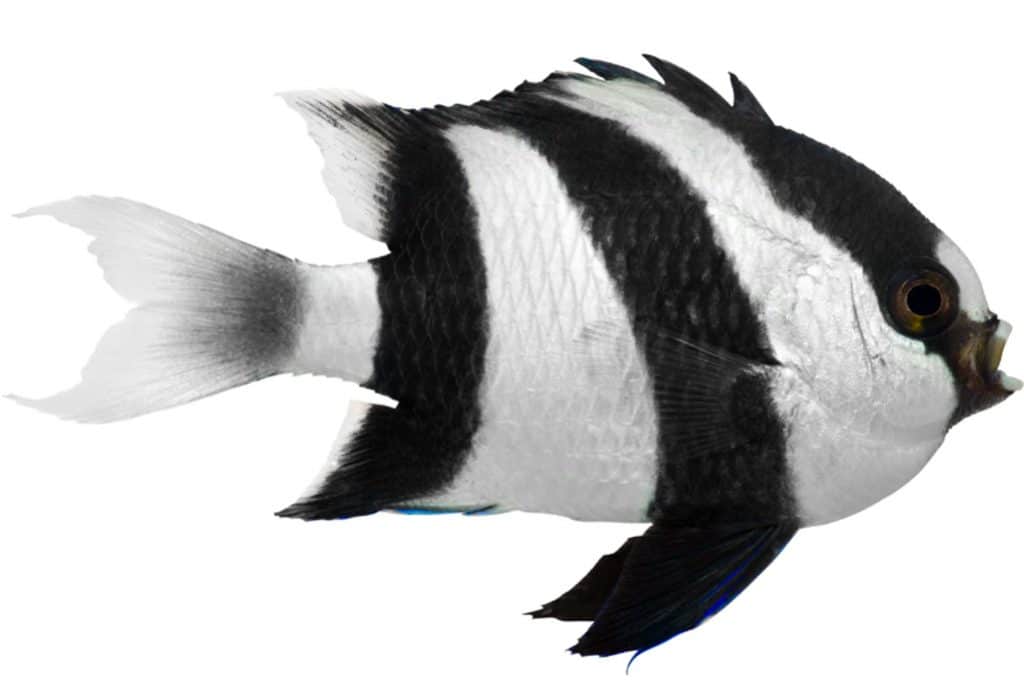
Three Stripe Damselfish
The three-stripe damselfish is a beautiful, vibrant fish that can be found in the Indo-Pacific oceans.
They are known for their showy dorsal fin and bright blue stripes on their white body.
This particular fish species spends most of its time schooling with other members of its species, but during mating season, males will separate themselves from the school to find females.
These demonstrations are done by changing coloration or forming patterns using the male’s tail fin colors.
The three-stripe damselfish is an important part of our marine ecosystem.
Because they feed on plankton which helps maintain balance in our aquatic communities.

Yellowtail Damselfish
The yellowtail damselfish is a small, brightly colored fish found in parts of the Pacific Ocean.
It has an average length of 4-5 inches and can live up to 10 years.
They are commonly used as pets and make good companions for other fish and invertebrates (organisms without a backbone).
The bright colors on their bodies serve two purposes:
- It helps them find food and mates during the day.
- But they also camouflage themselves at night when predators are more likely to attack.
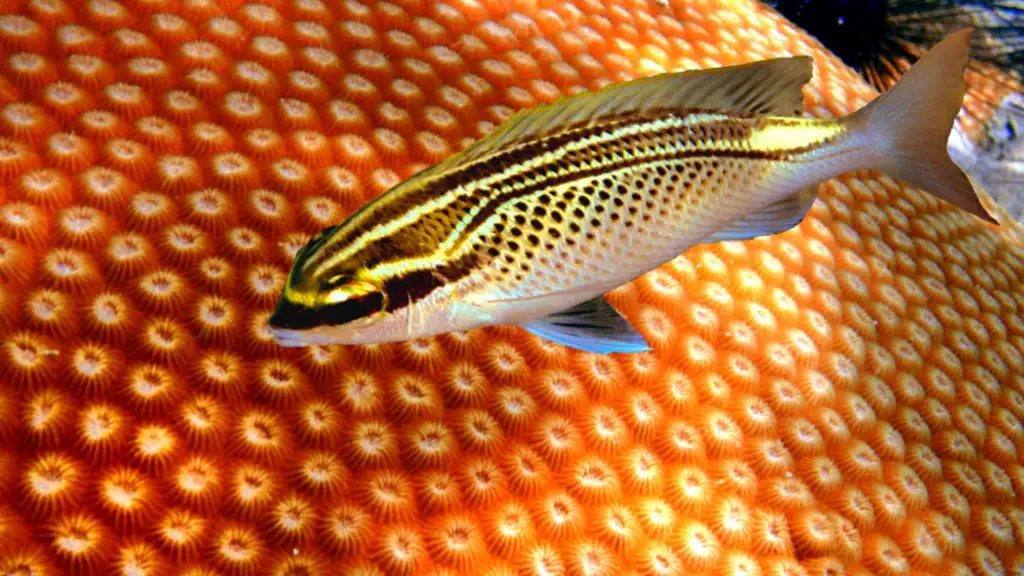
Bluestreak Cleaner Wrasse
The Bluestreak cleaner wrasse (Labroides dimidiatus) is a fish that has evolved to look like another fish to get close enough to eat the parasites and dead skin off of other reef fish.
This behavior, known as cleaning, benefits both parties involved: the cleaner gets food, and the client gains a health benefit from the cleaning service.
The blue stripe cleaner wrasse is sometimes kept in saltwater aquariums, yet its aggressive behavior needs constant monitoring owing to its specialized nutritional needs.

Green Chromis
The green Chromis is one of the more popular reef fish in the aquarium hobby, but it is also a very sensitive fish that requires regular water changes and excellent filtration.
Green Chromis are omnivores that obtain nutrients from algae and small animals they eat off of the live rock.
They do best in groups because they are extremely social creatures.
When harboring many green Chromis, a minimum tank size of 50 gallons with an abundance of live rock should be employed.

Blue Tang
The blue tang is a type of saltwater fish that is often found in the Indo-Pacific area.
They are typically bright silver or yellowish and have a distinctive black spot on their dorsal fin.
As far as size goes, they can grow up to about two feet long and weigh up to four pounds.
Their diet includes plankton, algae, octopus eggs, shrimp larvae, crustaceans, and mollusks.
Blue tangs don’t have any natural predators other than dolphins, who prey on them when there are abundant food sources.
The blue tang has been noted for being able to live in very warm water which ranges from 73°F – 86°F but prefers temperatures between 77°F – 82°F.

Ocellaris Clownfish
The Ocellaris Clownfish is the most common of all clownfish and can be found in various colors.
As a consequence of their demand in the aquarium trade, they have been overcollected.
This species is also commonly called “false percula” or “true percula,” with the last name more recently becoming accepted by many aquarists.
The ocellaris clownfish will typically grow to about 5 inches long but can get as big as 7 inches.
These fish have an average lifespan of three years when kept captive within regulated conditions, but they have been known to live up to seven years under proper care.
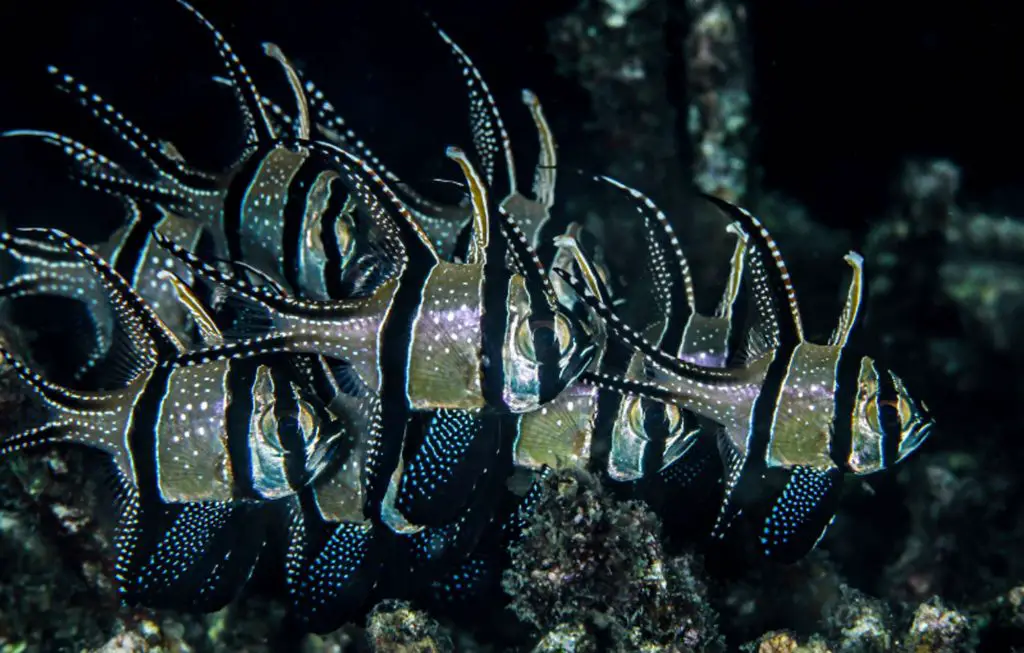
Banggai Cardinalfish
The Banggai Cardinalfish is one of the most popular marine aquarium fish.
This species requires much attention and care but can make for an amazing addition to your tank if you meet their requirements.
They are relatively quiet fish that spend the most of their time in the tank’s bottom areas, so they will not disturb any other tankmates.
They also have a unique personality that allows them to recognize their owner and respond to them differently than strangers who come into contact with them.
The Banggai Cardinalfish is one of the best choices for someone looking to start keeping saltwater aquariums home.
Because it has low maintenance needs, doesn’t require any special equipment or lighting upgrades, and thrives in most water conditions without requiring much attention from the owner.
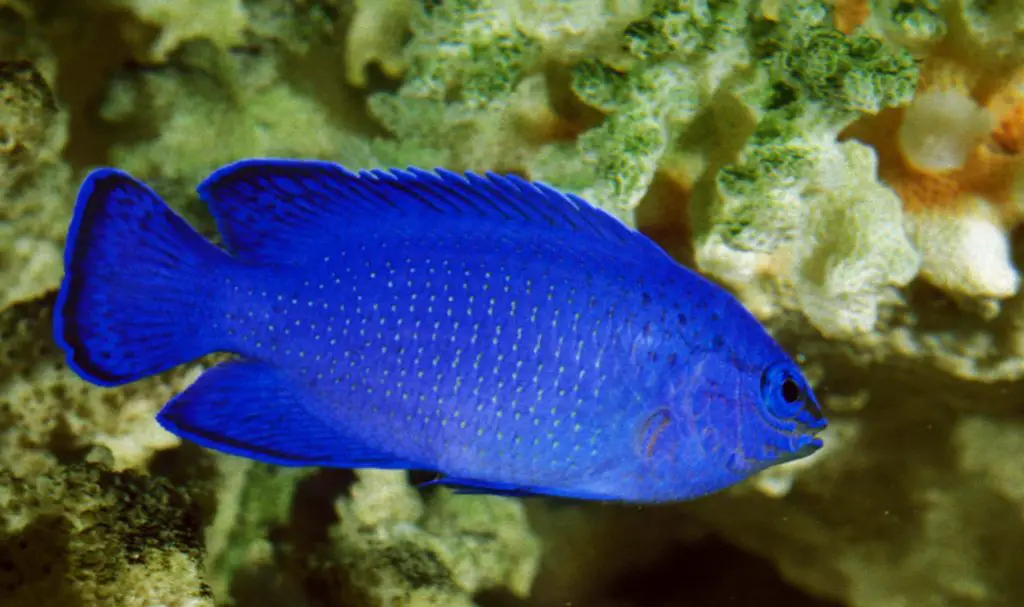
Blue Devil Damselfish
Blue Devil Damselfish is a popular fish in the aquarium trade.
Although they can be aggressive towards other damsels and even small fish like the Neon Goby, they are generally harmless to their keepers.
They can grow up to 2 inches long and live for about ten years with proper care.
Their diets should consist of meaty foods such as brine shrimp or Mysis shrimp along with algae wafers.
The Blue Devil Damselfish loves eating copepods, so it’s best to have some refugium where it can feed on this food source all day long!
This species also has many different color morphs ranging from blue-green to white-gold, making them very attractive to aquarium owners.
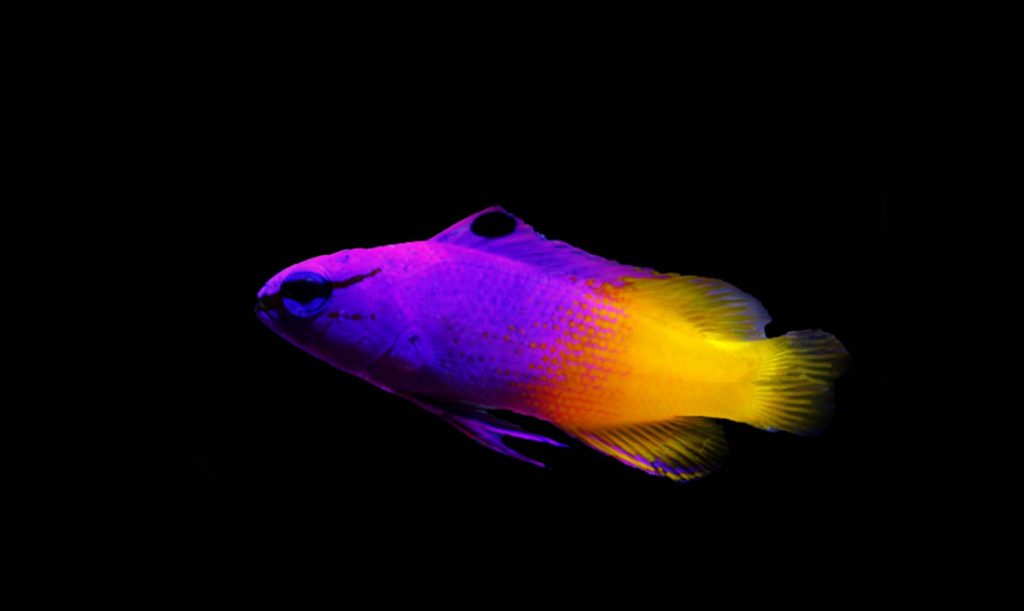
Royal Gramma Basslet
The Royal Gramma Basslet is a fish that may find in the Indo-Pacific.
They are typically found near coral reefs but come to shallower waters at night.
The Royal Gramma Basslet has a bluish-green coloration with white stripes and purple spots on its body; it also has two black lines running along each side of its body.
This species feeds mostly on small invertebrates like crabs and shrimp but will occasionally eat algae or plankton.
The Royal Gramma Basslet lives for an average of three years before dying due to natural causes (predators).
Weighing around two pounds when fully grown, this species does not often reproduce, contributing to their low population count.
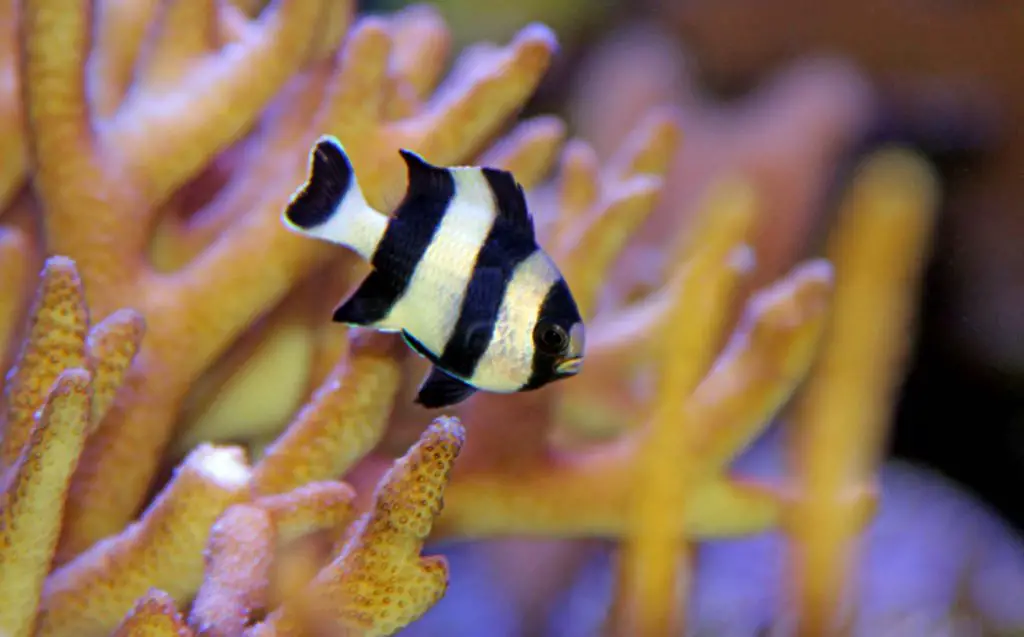
Four Stripe Damselfish
The Four Stripe Damselfish is a beautiful species of fish that can find in the Pacific Ocean.
The four stripe damsel has many different colors and patterns, making it easy to identify from other species.
They are known for the bright blue stripes and yellow dots on their body.
This fish species lives in rubble and areas with rocks or corals near the surface, where they can feed off plankton and small crustaceans.
The four stripe damselfish have been observed living at depths between 1-30 meters below sea level but usually stay around 10-20 meters deep due to their dietary needs.
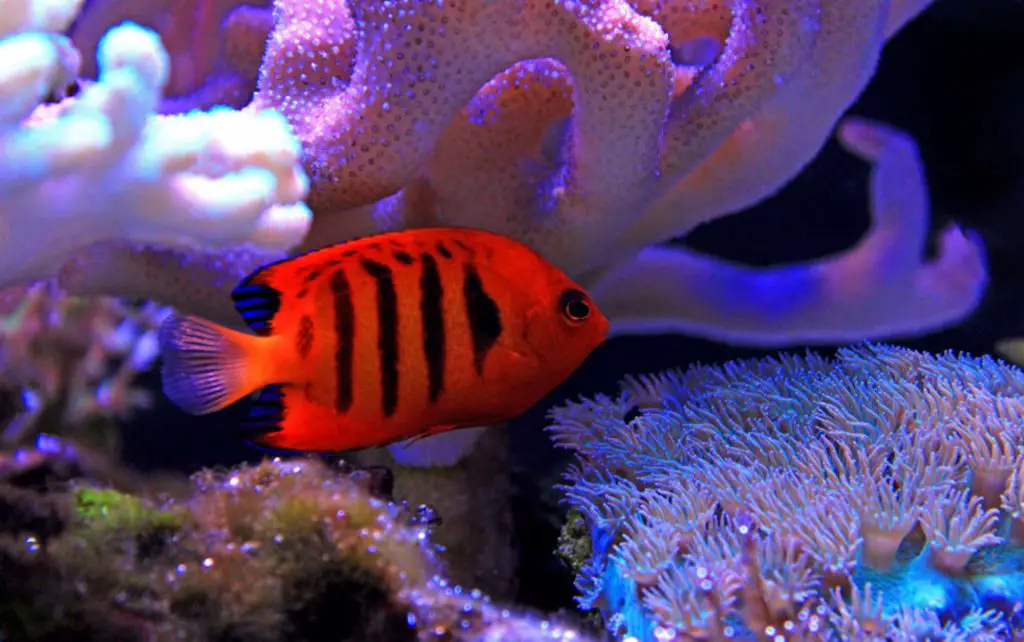
Flame Angelfish
The Flame Angelfish is also known as the Flaming or Red Sea Angelfish.
It belongs to the Pomacanthus family.
The fish has an average lifespan of 10-20 years and can grow up to 12 inches in length.
Scientifically, it is called the Centropyge loculus.
A popular aquarium pet, this species of angelfish gets its name from the aristocratic appearance with a bright red body covered in yellow stripes, which give them an elegant look (“Flame Angelfish”).
This exotic-looking fish is recognized by its deep reddish-orange coloration with bright yellow vertical bands.
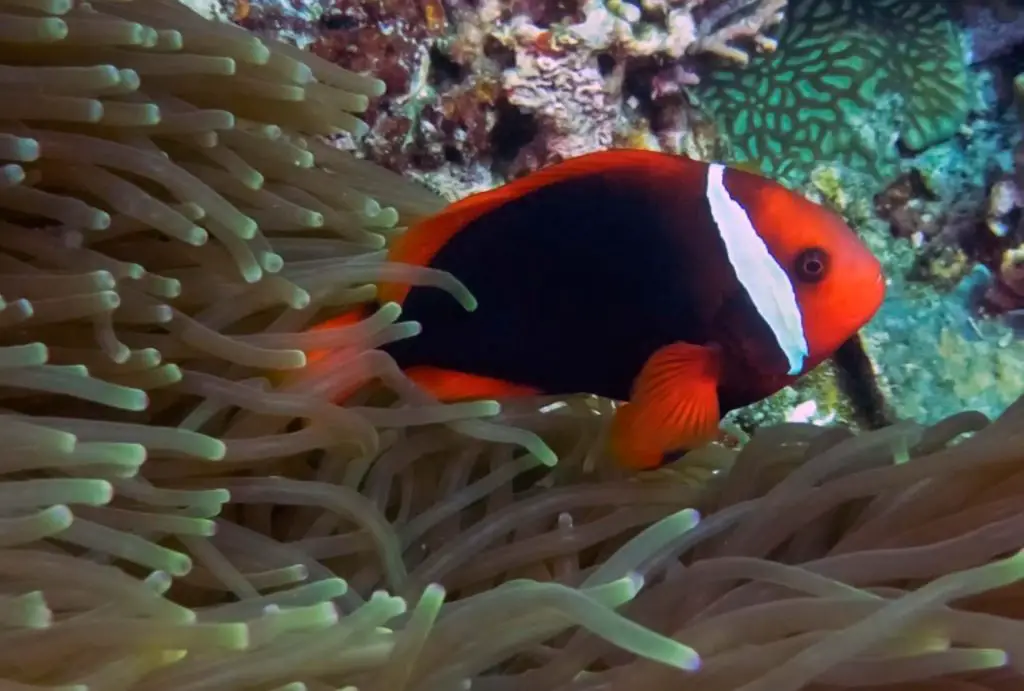
Tomato Clownfish
The Tomato Clownfish is an enthralling aquatic creature.
It may be found in many different shades, forms, and dimensions.
Along the coastlines of Australia and Indonesia, they may be discovered.
This species can get as long as 12 inches!
Most people don’t know that they also have an incredible sense of smell which helps them find food sources like sponges or clams on rocks during low tide.
It is claimed that this species’ primary problem is that it is on the verge of extinction.
It’s happening because people do many things near their homes, like fishing, dredging for sand, offshore mining, etc.
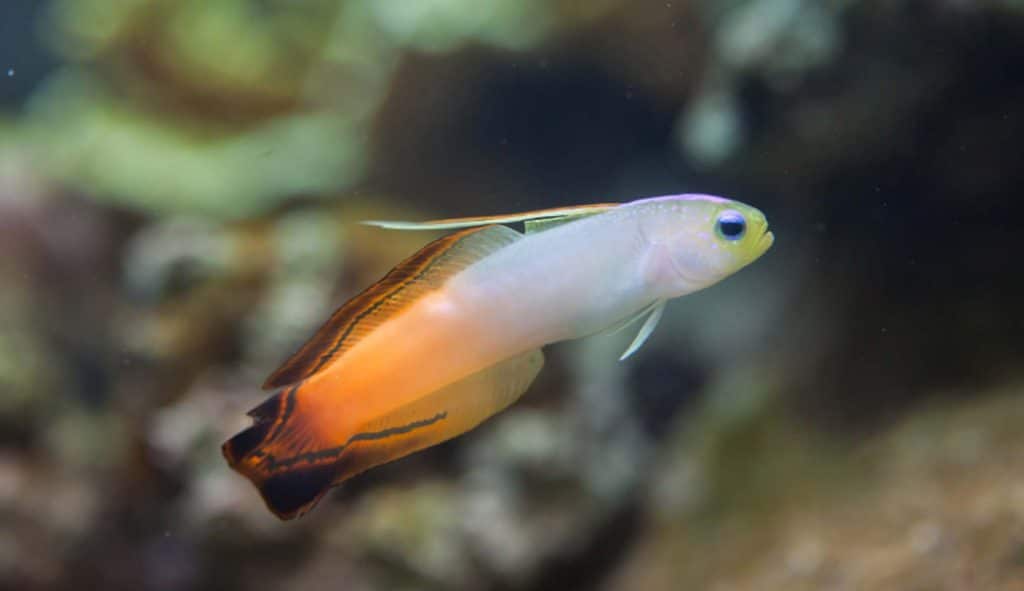
Firefish Goby
The firefish goby is a species of unusual fish, which lives in symbiosis with sea anemones.
They may be found in the Indian and Pacific seas from East Africa to Hawaii.
Although they have a very small range of habitats, these creatures can be quite common within their habitat ranges.
Because they live near the bottom of the ocean floor at depths between 1m and 20 m during the day,
they spend most of their time hiding from predators or looking for food.
At night, however, it is a different story as this nocturnal creature comes out to feed on plankton that drifts down from above them.
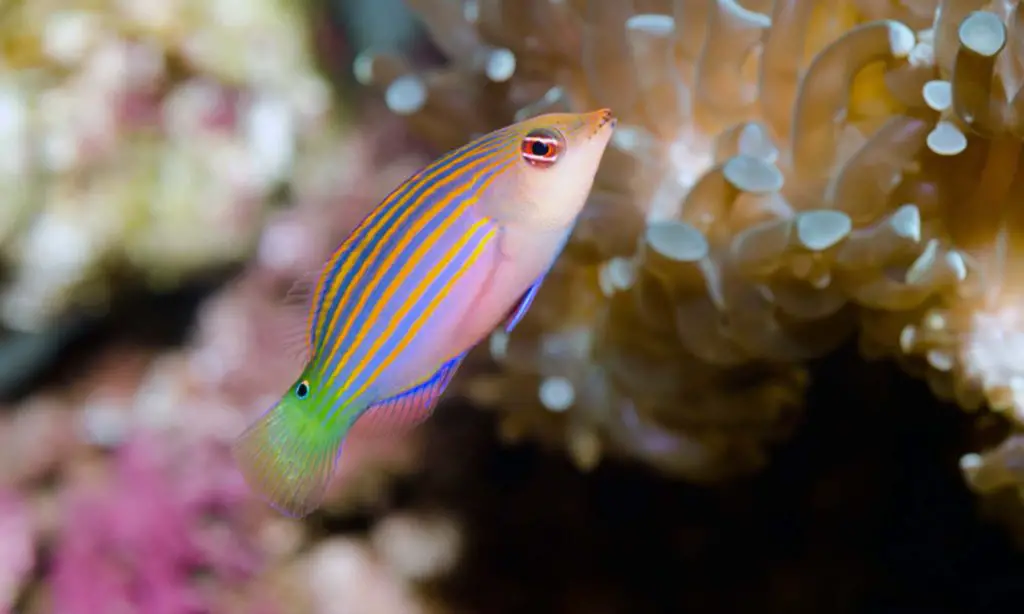
Six-line Wrasse
The six-line wrasse is a fish that can be found in the Indo-Pacific.
It lives at depths of .6 to 162 meters and typically inhabits coral reefs.
This species, also known as the blueback wrasse, has been spotted swimming with other reef inhabitants, such as clownfish, anemones, and angelfish.
The six-line wrasse has a thin body and six horizontal lines running across its back from head to tail.
Its scales are used for camouflage purposes against predators who would normally hunt by sight alone;
this makes it difficult for any potential predator to see them because they blend into their surroundings so well.
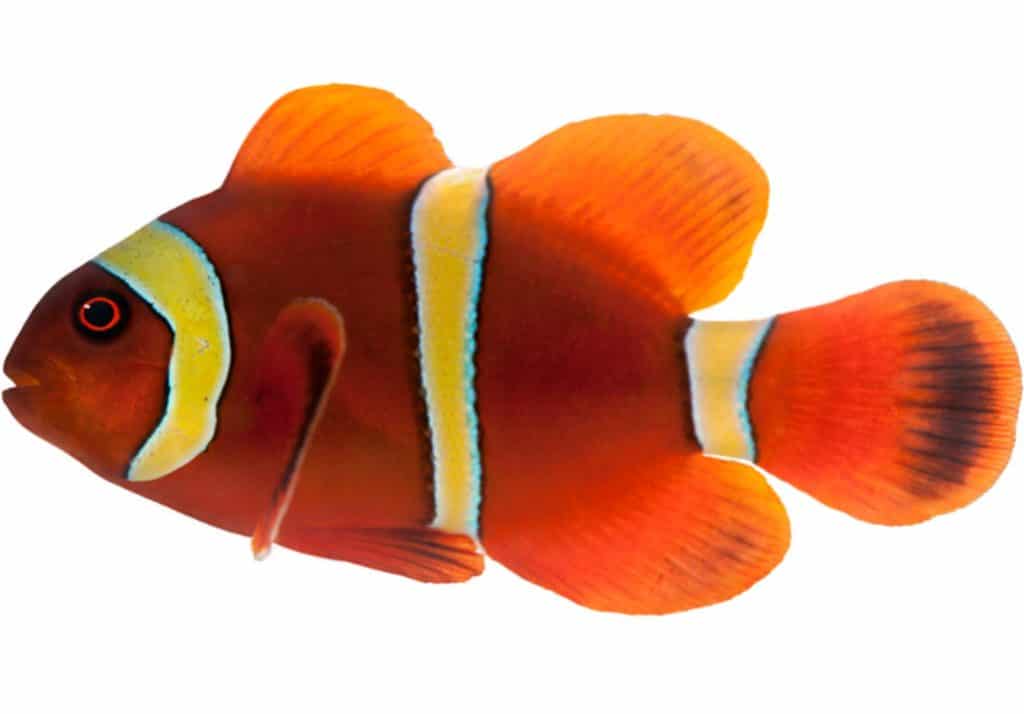
Maroon Clownfish
A maroon clownfish is a type of fish that lives in the waters surrounding Australia.
The maroon clownfish can be found at depths ranging from 5 to 30 meters below sea level, and they live around coral reefs.
They are small fish with an oval-shaped body and a bright orange stripe on each side of their body just behind their eyes.
This stripe helps them blend in with the reef, which makes it hard for predators to see them.
The maroon clownfish will turn white or pale when it feels threatened so it can blend in with its surroundings.
And protect itself from bigger fish that might try to eat it, like barracudas, groupers, snappers, jacks, and other predatory fish.

Pajama Cardinalfish
Pajama cardinalfish is a type of fish found in the Indian and Pacific oceans.
They are usually red, white, or black with two stripes that run along their body.
These stripes are often referred to as pajamas because they look like children’s clothes.
The pajama cardinalfish is also called the zebra-striped cardinalfish due to its striped appearance.
Scientists have seen these fish anywhere from 3 meters to 200 meters deep, making it hard for them to study because it’s hard to dive that far down into the water.
Equipment’s for saltwater aquarium
Filter
Heater
Lighting
Lamp
Plumbing equipment
Decorations, ornaments, and rocks
Maintenance Tools & Supplies
Air Pump
Air Stones
Sea Salt Mix/Saltwater & Hydrometer
Supplies for the fish tank – food, water conditioner, aquarium salt mix, thermometers, etc.
The common task list of Regular Fish Maintenance
Feed the fish.
Water tests
Top up water evaporation.
Fish health check.
Remove/change filter media
Check fish tank temperature and other equipment
Aquarium cleaning
The time needed to maintain a saltwater tank?
A saltwater tank is an excellent option for both beginners and professionals since it combines the greatest aspects of a freshwater aquarium and a saltwater reef in a single system.
All in all, this type of aquarium will require about 20-30 minutes per week to keep up with the maintenance process.
The most critical element of tank maintenance is cleaning the sand periodically to remove hazardous bacteria.
Feeding your fish is also essential, but since they can take care of themselves, I won’t go into too much detail about that process here!
Lastly, keep the water parameters and balance in check by testing the water at least once a week to ensure it has the right amount of salt.
How much does it cost to keep a saltwater tank in good condition?
Setting up a saltwater tank is a significant purchase and requires an initial investment.
Aquarists agree that the initial expense greatly pays off in long-term enjoyment and requires little to no maintenance afterward.
Setting up your saltwater aquarium should cost you about $500, including bowls, rocks, supplies, and living creatures.
Purchasing equipment for these tanks can range from $200 upwards to thousands of dollars, depending on the complexity inherent in the setup.
In general, most aquarists say they were worth it, provided they obtained what they desired from their experience with them over time.
Saltwater vs freshwater aquariums
In general, most aquarists say they were worth it, provided they obtained what they desired from their experience with them over time.
We say this for a couple of reasons:
- Saltwater species tend to be much more colorful than freshwater species- they also have coral, which adds visual interest to the tank.
- There’s so much variety in terms of options in these tanks: if you want tropical fish and plants and don’t want corals and snails in your setup, you can purchase artificial décor; with a freshwater aquarium, everything needs to come from nature (which usually means plants with soft colors or flowers) or from online dealers.
The drawbacks of saltwater aquariums are that they are much more costly to set up, tend to have fewer plant alternatives since coral is necessary, and can need more maintenance due to the complexity of their environment.
A bigger setup, more equipment, and more money are needed to maintain saltwater aquariums. The evolutionary distance from fish to freshwater makes them harder to care for, but saltwater environments are also much more diverse in the number of fish and life forms that inhabit them.
They can typically house stinging jellyfish and all sorts of other creatures that don’t exist in freshwater environments. These “special” creatures not only look beautiful within the tank, but they also have many beneficial attributes to an ecosystem beyond what regular fish can offer.
Water chemistry is a lot more unpredictable with saltwater tanks because it’s so dependent on outside factors such as aquarium size and other types of water mixing abilities around the tank. One should always beware, and be happy about, the fact that saltwater tanks can leak and lose all of their water.
Summary
As you can see, maintaining a saltwater fish tank is not so complicated if you follow the steps outlined in this article.
You should be able to keep your new pet happy and healthy for years with some routine maintenance.
Please feel free to get in touch with us if you have any questions or concerns about saltwater aquariums.
We are always delighted to assist!
